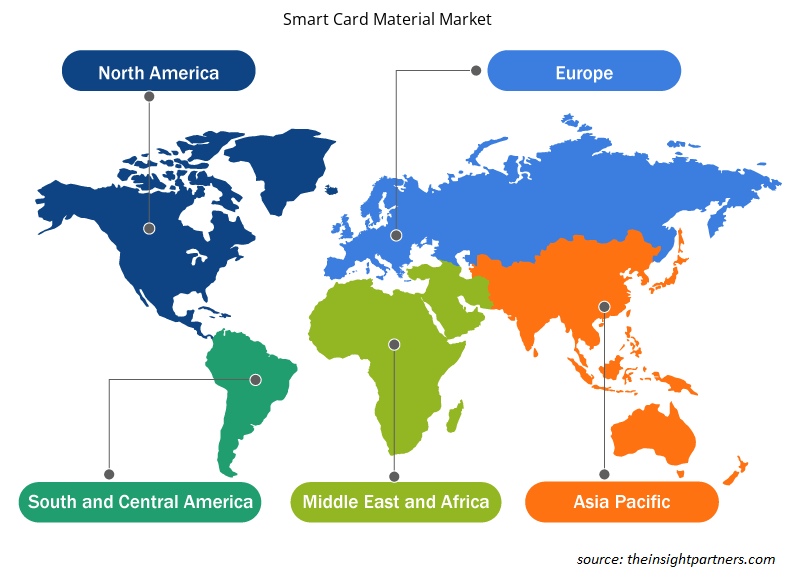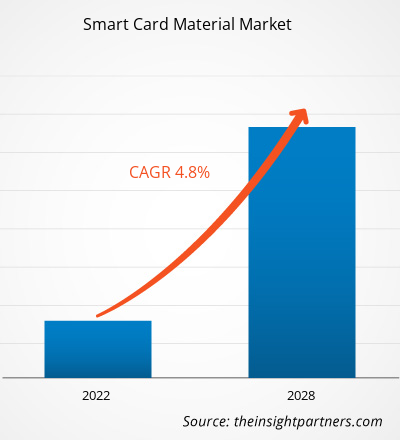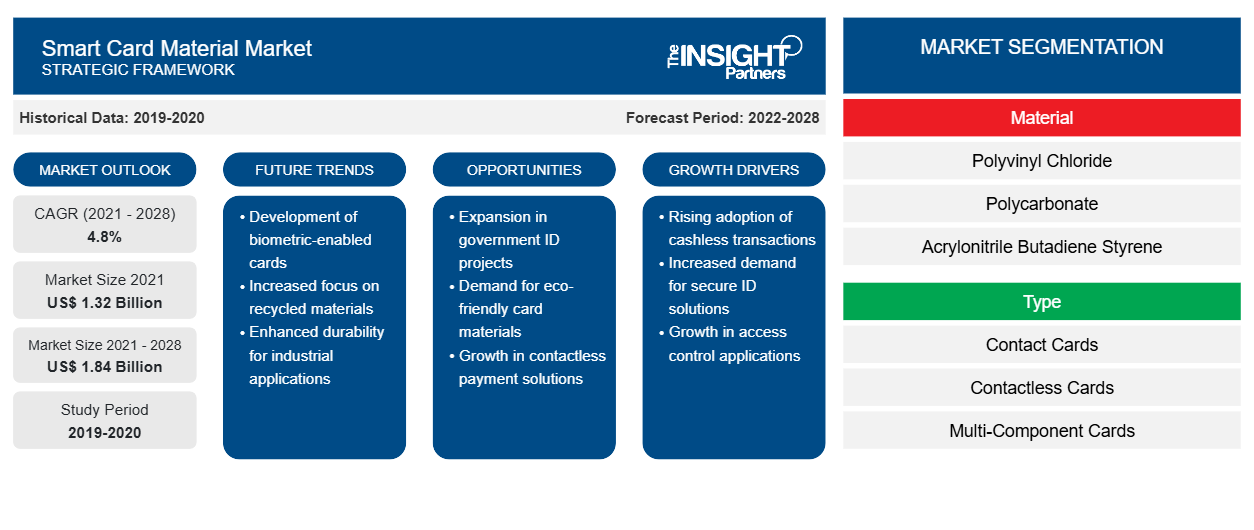Si prevede che il mercato dei materiali per smart card raggiungerà 1.837,78 milioni di dollari entro il 2028, rispetto ai 1.324,57 milioni di dollari del 2021; si prevede una crescita a un CAGR del 4,8% dal 2021 al 2028.
Una smart card, un tipo di chip card, è una carta di plastica che contiene un chip di computer incorporato, sia di tipo memoria che microprocessore, che memorizza e gestisce dati. Questi dati sono solitamente associati a un valore o a un'informazione, o a entrambi, che vengono memorizzati ed elaborati all'interno del chip. I materiali delle smart card si riferiscono a materiali chimici utilizzati nella fabbricazione di queste carte. Questi materiali supportano l'incorporamento e la stampa di informazioni su di essi.
Nel 2020, l'Asia Pacifica deteneva la quota maggiore del mercato globale dei materiali per smart card . La domanda di materiali per smart card in questa regione è in aumento a causa del crescente utilizzo delle smart card nel settore delle telecomunicazioni. Inoltre, la crescente tendenza alla globalizzazione e la proliferazione del settore bancario, dei servizi finanziari e delle assicurazioni (BFSI) sono fattori chiave che favoriscono la crescita del mercato dei materiali per smart card nella regione.
Personalizza questo report in base alle tue esigenze
Riceverai la personalizzazione gratuita di qualsiasi report, comprese parti di questo report, o analisi a livello nazionale, pacchetto dati Excel, oltre a usufruire di grandi offerte e sconti per start-up e università
-
Scopri le principali tendenze di mercato in questo rapporto.Questo campione GRATUITO includerà analisi di dati che spaziano dalle tendenze di mercato alle stime e alle previsioni.
Impatto della pandemia di COVID-19 sul mercato dei materiali per smart card
L'attuale pandemia di COVID-19 ha alterato drasticamente lo stato del settore chimico e dei materiali e ha avuto un impatto sulla crescita del mercato dei materiali per smart card. Il calo significativo delle performance di diversi settori industriali ha avuto un impatto sulla domanda di materiali per smart card. L'impatto della pandemia varia nei diversi segmenti applicativi. Un'impennata nel traffico dati e nei servizi vocali ha giovato a molti operatori delle telecomunicazioni, tra cui gli operatori di data center mobili e a banda larga. Tuttavia, le misure di blocco imposte dai governi hanno disturbato le catene di fornitura di materie prime come PVS, ABS e PETG necessarie per la produzione di smart card. La diffusione della malattia ha avuto un impatto negativo sulle operazioni nei settori governativo e BFSI. Tuttavia, poiché le economie stanno pianificando di rilanciare le loro operazioni, si prevede che la domanda di materiali per smart card aumenterà a livello globale nei prossimi anni.
Approfondimenti di mercato
Crescita significativa nei settori delle telecomunicazioni e dell'assistenza sanitaria
Le smart card sono ampiamente utilizzate nel settore delle telecomunicazioni. L'uso più importante delle smart card in questo settore è sotto forma di schede SIM (Subscriber Identity Module) o schede a circuito integrato universale (UICC). Queste smart card sono prodotte principalmente da materiali in polivinilcloruro (PVC) e acrilonitrile butadiene stirene (ABS). La tecnologia delle smart card utilizzata nelle applicazioni in questo settore ha subito continui progressi negli ultimi anni, il che ha aumentato il consumo di queste card. Inoltre, le organizzazioni sanitarie in tutto il mondo stanno implementando smart health card con un'ampia gamma di funzionalità e applicazioni.
Approfondimenti regionali sul mercato dei materiali per smart card
Le tendenze regionali e i fattori che influenzano il mercato dei materiali per smart card durante il periodo di previsione sono stati ampiamente spiegati dagli analisti di Insight Partners. Questa sezione discute anche i segmenti e la geografia del mercato dei materiali per smart card in Nord America, Europa, Asia Pacifico, Medio Oriente e Africa e America centrale e meridionale.

- Ottieni i dati specifici regionali per il mercato dei materiali per smart card
Ambito del rapporto sul mercato dei materiali per smart card
| Attributo del report | Dettagli |
|---|---|
| Dimensioni del mercato nel 2021 | 1,32 miliardi di dollari USA |
| Dimensioni del mercato entro il 2028 | 1,84 miliardi di dollari USA |
| CAGR globale (2021 - 2028) | 4,8% |
| Dati storici | 2019-2020 |
| Periodo di previsione | 2022-2028 |
| Segmenti coperti |
Per materiale
|
| Regioni e Paesi coperti |
America del Nord
|
| Leader di mercato e profili aziendali chiave |
|
Densità dei player del mercato dei materiali per smart card: comprendere il suo impatto sulle dinamiche aziendali
Il mercato dei materiali per smart card sta crescendo rapidamente, spinto dalla crescente domanda degli utenti finali dovuta a fattori quali l'evoluzione delle preferenze dei consumatori, i progressi tecnologici e una maggiore consapevolezza dei vantaggi del prodotto. Con l'aumento della domanda, le aziende stanno ampliando le loro offerte, innovando per soddisfare le esigenze dei consumatori e capitalizzando sulle tendenze emergenti, il che alimenta ulteriormente la crescita del mercato.
La densità degli operatori di mercato si riferisce alla distribuzione di aziende o società che operano in un particolare mercato o settore. Indica quanti concorrenti (operatori di mercato) sono presenti in un dato spazio di mercato in relazione alle sue dimensioni o al valore di mercato totale.
Le principali aziende che operano nel mercato dei materiali per smart card sono:
- Società chimica Eastman
- Società PetroChina Limited
- Società Solvay SA
- KEM UNO
- SABICO
Disclaimer : le aziende elencate sopra non sono classificate secondo un ordine particolare.

- Ottieni una panoramica dei principali attori del mercato dei materiali per smart card
Approfondimenti sulle applicazioni
In base all'applicazione, il mercato dei materiali per smart card è segmentato in BFSI, governo, telecomunicazioni, vendita al dettaglio, sanità, ospitalità e altri. Il segmento delle telecomunicazioni ha detenuto la quota maggiore del mercato dei materiali per smart card nel 2020. Le smart card sono utilizzate come schede telefoniche prepagate (schede di memoria a valore memorizzato) e schede SIM basate su smart card a microprocessore o UICC nei telefoni cellulari. I prodotti smart card più venduti in questo settore sono SIM e UICC, in termini di volume e valore.
Tra i protagonisti del mercato globale dei materiali per smart card figurano Eastman Chemical Company, PetroChina Company Limited, Solvay SA, KEM ONE, SABIC, 3A Composites GmbH, Teijin Limited, LG Chem, BASF SE e Westlake Chemical Corporation.
Segnala i riflettori
- Tendenze industriali progressive nel mercato dei materiali per smart card per aiutare gli operatori a sviluppare strategie efficaci a lungo termine
- Strategie di crescita aziendale adottate dalle aziende che operano nei mercati sviluppati e in via di sviluppo
- Analisi quantitativa del mercato dei materiali per smart card dal 2019 al 2028
- Stima della domanda globale di materiali per smart card
- Analisi delle cinque forze di Porter per illustrare l'efficacia degli acquirenti e dei fornitori che operano nel settore
- Sviluppi recenti per comprendere lo scenario competitivo del mercato
- Tendenze e prospettive di mercato, nonché fattori che guidano e frenano la crescita del mercato dei materiali per smart card
- Assistenza nel processo decisionale evidenziando le strategie di mercato che sostengono l'interesse commerciale, portando alla crescita del mercato dei materiali per smart card
- La dimensione del mercato dei materiali per smart card in vari nodi
- Panoramica dettagliata e segmentazione del mercato, nonché dinamiche del settore dei materiali per smart card
- Dimensioni del mercato dei materiali per smart card in varie regioni con promettenti opportunità di crescita
Mercato dei materiali per smart card
Per materiale
- Cloruro di polivinile (PVC)
- Policarbonato (PC)
- Acrilonitrile Butadiene Stirene (ABS)
- Polietilene tereftalato-glicole (PETG)
- Altri
Per tipo
- Schede di contatto
- Carte contactless
- Schede multicomponente
Per applicazione
- BFSI
- Governo
- Telecomunicazione
- Vedere al dettaglio
- Assistenza sanitaria
- Ospitalità
- Altri
Profili aziendali
- Società chimica Eastman
- Società PetroChina Limited
- Società Solvay SA
- KEM UNO
- SABICO
- 3A Compositi GmbH
- Teijin limitata
- LG Chimica
- BASF SE
- Società chimica Westlake
- Analisi storica (2 anni), anno base, previsione (7 anni) con CAGR
- Analisi PEST e SWOT
- Valore/volume delle dimensioni del mercato - Globale, Regionale, Nazionale
- Industria e panorama competitivo
- Set di dati Excel
Report recenti
Testimonianze
Motivo dell'acquisto
- Processo decisionale informato
- Comprensione delle dinamiche di mercato
- Analisi competitiva
- Analisi dei clienti
- Previsioni di mercato
- Mitigazione del rischio
- Pianificazione strategica
- Giustificazione degli investimenti
- Identificazione dei mercati emergenti
- Miglioramento delle strategie di marketing
- Aumento dell'efficienza operativa
- Allineamento alle tendenze normative























 Ottieni un campione gratuito per - Mercato dei materiali per smart card
Ottieni un campione gratuito per - Mercato dei materiali per smart card